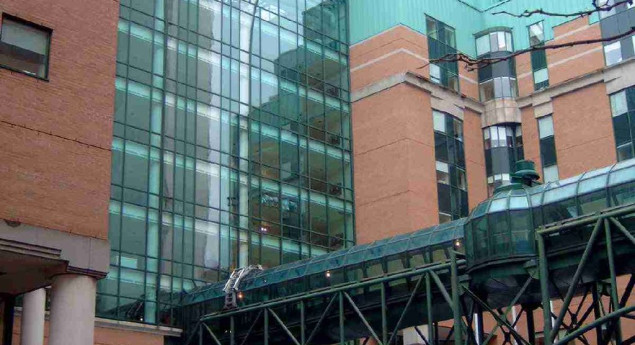The Hospital for Sick Children (SickKids), affiliated with the University of Toronto, is Canada's most research-intensive hospital and the largest centre dedicated to improving children's health in the country. As innovators in child health, SickKids improves the health of children by integrating care, research and teaching.
With a staff that includes professionals from all disciplines of health care and research, SickKids provides the best in complex and specialized care by creating scientific and clinical advancements, sharing knowledge and expertise and championing the development of an accessible, comprehensive and sustainable child health system.
It all began way back in the spring of 1875, when a group of Toronto women led by Elizabeth McMaster rented an 11-room house in downtown Toronto for $320 a year, set up six iron cots and declared open a hospital "for the admission and treatment of all sick children." On April 3, Maggie, a scalding victim, became SickKids' very first patient.
In that first year, 44 patients were admitted to the Hospital. Sixty-seven others were treated in outpatient clinics.
The demand for services was so great that the Hospital had to move to a larger building in 1876. But even the larger building and its 16 beds were too few. In 1891, under the leadership of John Ross Robertson, publisher of the Evening Telegram and chairman of the Hospital's Board of Trustees, SickKids moved to an impressive new four-story, 320-bed facility at the corner of Elizabeth and College Streets. The Toronto city council asked that it be named Victoria Hospital for Sick Children, but the new name was never officially adopted.
A few years later, in 1908, the Hospital installed the first milk pasteurization plant in Canada, 30 years before it became mandatory. SickKids staff lead the fight in Canada for compulsory pasteurization.
The Nutritional Research Laboratory was established in 1918. Work commenced which led to the development of Pablum and content standards for Canadian bread, flour, and agricultural products. The results of nutritional research by Drs. Alan Brown, Fred Tisdall and Theo Drake led to the development of Pablum, a precooked baby cereal. Although it tasted like boiled Kleenex to the adult palate, Pablum saved thousands of children from death and disease.
The polio epidemic hit in 1937 and SickKids workshop staff were kept busy manufacturing more than 30 iron lungs for use throughout Ontario. Medical and nursing staff organized temporary treatment centres that cared for more than 300 children. During the epidemic, the Hospital's Orthopaedic Workshop made more than 3,000 splints and braces in a period of six weeks.
On February 4, 1951, the Hospital moved to its current location at 555 University Avenue, occupying the grounds where the childhood home of actress Mary Pickford once stood. At the same time, there was a switch in emphasis from nutritional research to the repair of congenital defects. Three years later, the Research Institute was established.
The Hospital also pioneered renowned surgical developments such as the Salter operation to repair dislocation of the hip and the Mustard operation to correct a heart defect that was often fatal. In the 1960s, SickKids opened one of the first intensive care units in North America devoted exclusively to the care of critically-ill newborn and premature babies.
Throughout the 1980s, advances in genetics have led to the identification and cloning of a number of genes responsible for causing hereditary diseases such as Duchenne muscular dystrophy and cystic fibrosis. And there are many more milestones.
In January of 1993, SickKids opened a new patient-care wing, the Atrium, just behind the 555 site. The Atrium was designed by Eberhard Zeidler of Zeidler Roberts Partnership. Believing that light is important to healing, Zeidler designed the building around a nine-storey, glass-roofed atrium to let in as much natural light as possible. The $232-million (CAD.) Hospital has been paid for by taxpayers and contributors to the Hospital's capital campaign, SickKids Foundation, and other donors and bequests.
Most patients now have their own room, with a washroom, storage, and a day bed so a parent can stay at night. The Atrium houses exciting facilities to help provide enhanced care and improve the treatment and diagnosis of childhood disease. The Critical Care Unit, where children with life threatening illness and injury receive care, almost doubled in size to 36 beds. The Emergency Department has two trauma rooms and a six-bed observation room.
In September of 2013, SickKids opened the Peter Gilgan Centre for Research and Learning. Towering 21 storeys above ground level at Bay and Elm streets, just a few steps from the Hospital, the Gilgan Centre is a hub where researchers and learners congregate and share ideas to transform the current state of child health care. The world-class facility houses over 2,000 SickKids scientists and their staff and currently has 210 labs up and running. Before the Gilgan Centre opened, SickKids research staff were scattered across six buildings. Now, united in what is believed to be the largest child health research tower in the world, the Gilgan Centre and its large, multi-level open spaces has become a catalyst for sparking new interactions between researchers across different fields of study.
416-813-1500
http://www.sickkids.ca/
@SickKidsNews
Earn 10 points!
Photo: Wikipedia










